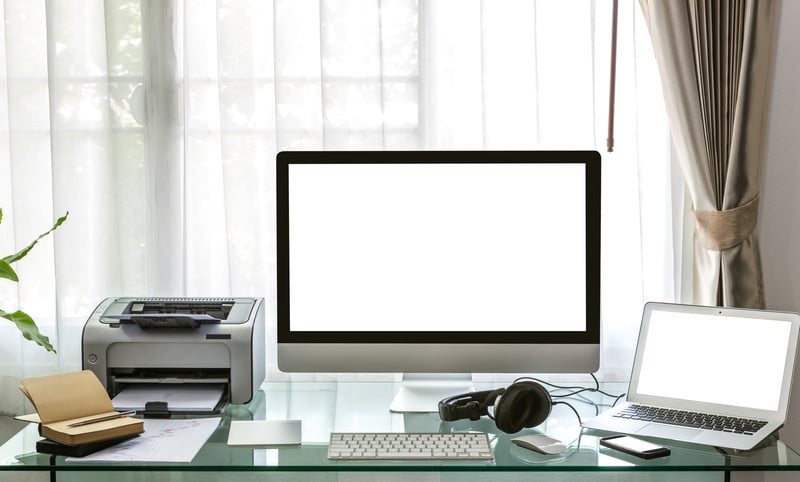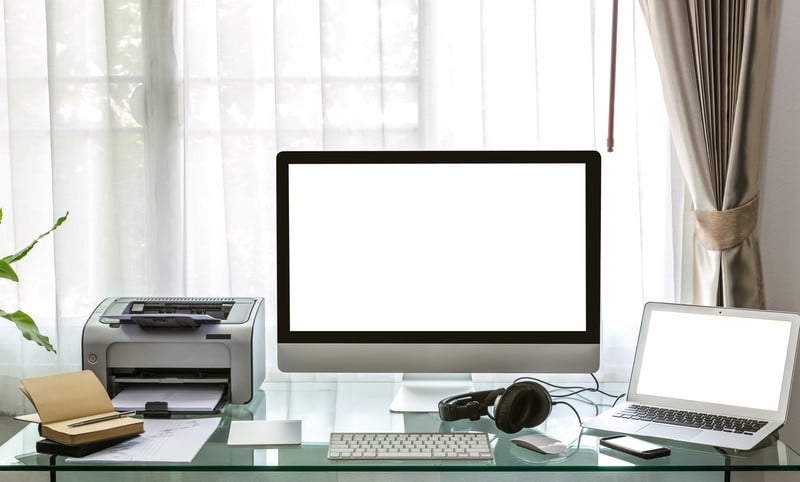Millions of Americans are enjoying the flexibility of working from home today as we do our best as a nation to “flatten the curve” of the coronavirus. Not only does working from home provide more time and freedom to get work done on your own schedule but it also provides a valuable tax-savings deduction as an added bonus.
If you’re a business owner, independent contractor or otherwise self-employed and you work out of your home on a regular basis, then it does open up this valuable tax deduction for you. Here’s how to make sure that you qualify for it.
How Do I Qualify for the Home Office Tax Break?
Small business owners, entrepreneurs and other self-employed folks who work from home can save big money on their taxes by taking the home office deduction, as long as you meet the IRS’ requirements and keep good records.
If you use any part of your home regularly and exclusively for business-related activity, the IRS lets you write off associated rent, utilities, real estate taxes, repairs, maintenance and many other expenses. And it’s not limited only to homeowners either. The home office tax deduction is also available to renters too. The deduction rules also apply to any freestanding structure just as long as that structure is used exclusively and regularly to conduct your business.
Here’s what you need to know about the home office deduction.
It’s simple. If you have a dedicated workspace in your home, perhaps a spare room, basement, attic or even a loft over your garage-AND-you use this location regularly to conduct business, then you may qualify for the home office deduction and write off the cost of your workspace, plus you could earn additional tax-saving deductions as well.
Fair warning, some accountants may try and talk you out of taking the home office deduction, perhaps your CPA already has. They’re often worried it could raise a red flag, or the tax savings involved may not be enough to make the deduction worthwhile.
But if it’s done properly, and documented correctly, that’s simply not true.
Follow These Guidelines for Foolproof Home Office Tax Savings
The home office deduction is a time-honored tax savings strategy, recognized for years by the IRS. Like any other tax deduction, you simply need to make certain you qualify for this deduction, and the tax savings are yours to keep, money you can put right back into your pocket or invest back in your business.
So how do you qualify? There are two main requirements that are easy for you to determine:
- Exclusive: You must use part of your home only for businesses
- Regular: You must use your home office space for business on a regular basis
To take advantage of this tax saving deduction, you must meet both of the above requirements, and meet any ONE of the following:
- The home office is your principal place of business
- You regularly and exclusively use your home office for business activities, including managerial or administrative work
- You meet clients or customers at your home office
- You have a separate structure on your property used only for business purposes
- You store inventory or product samples at home
Principal place of business: Although your home office doesn’t have to be the only place you meet with clients or customers, it must either be the principal location for your business, or a place where you regularly meet with customers or clients. Your home office workspace must be used regularly in the conduct of your business, AND the space must be used exclusively for that purpose. So, what does that mean exactly?
Regular use: Means you use a specific area of your home on a frequent basis, not just once in a while. For example, let’s say you have a home office workspace set up in a spare bedroom and use it on a weekly basis to contact and schedule clients or perhaps bill customers. This would meet the test of regular use.
If on the other hand, you only work from your home office space occasionally, a few times a year and its use is incidental to your business, this would most likely not qualify as regular use.
The definition of exclusive use also means that you must use a specific area of your home only for your trade or business. Your home office workspace can be as small as a desk or as big as an entire room. There’s no specific size requirement. The space must be identified as separate but does not need to be a permanently partitioned off area of your home.
For example, let’s say you have set up a home office workspace in the corner of your living room or den. In that workspace you have your desk, business computer, and printer. This would meet the test of exclusive use, even though the space is a shared room in your home.
However, if you set up the same home office workspace in one of your spare bedrooms and this space also has a pullout couch which is used by house guests for occasional overnight stays, that would disqualify you from taking the home office deduction.
Also, if you use part of your home for storage of product samples or inventory, that’s another exception to the exclusive use rule. You may use part of this space for personal purposes and still qualify for the home office deduction.
For instance, let’s say your home-based business sells home-cleaning products and that you regularly use half of your basement to store inventory. Occasionally using that part of the basement to store personal items would not disqualify you from taking the home office deduction. But to qualify for this exception, your home must be the only location of your business.
Remember, your home office must be either your principal business location, OR a place where your regularly meet with customers or clients.
If you are self-employed or own a small business and work from home running that business, your home is your principal place of business. Alternatively, if you work from another location too, you may still qualify your home as your principal place of business if you use it exclusively and regularly for administrative or management activities.
Even if you are an employee of another company but also have your own part-time business based in your home, you can qualify for the deduction even if you spend more time at the office where you work as a full-time employee. This rule makes it much easier to claim home office deductions for individuals who conduct most of their income-earning activities somewhere else such as outside salespeople, tradespeople, or professionals.
Just What Qualifies as a Business?
Of course, to qualify for the home office tax deduction the first question you must answer is: what constitutes your business? If you’re self-employed or run your own small business, then the answer should be clear cut. Still, there are some gray areas, so let’s take a closer look.
As with the regular-use test, whether your work qualifies as a business depends on the circumstances – the more substantial the activities, in terms of time and effort invested and income generated, the more likely you are to qualify for the home office deduction.
Making money from your efforts is a prerequisite, but for purposes of this tax deduction, profit alone isn’t necessarily enough.
How Big of a Tax Savings are We Talking About?
The amount of the tax savings you stand to earn will depend on the costs incurred in running your business. But the home office tax deduction often provides significant tax savings because you may be able to include a portion of your home mortgage or rent plus many other standard household expenses including a portion of your utilities and insurance. Also, a home office deduction may unlock other deductions like an increased mileage deduction.
Your actual home office workspace is just a starting point, you can also add your home office furniture and office equipment. Your phone, computer, printer, file cabinet, desk and chair, pictures and paintings, bookcase and books and furniture.
Then there’s the supplies that you use, high-speed internet connections, online and physical subscriptions, home office supplies and some snacks. Taken together, this can be a couple thousand dollars a year in deductions.
There are two easy ways to calculate the home office deduction: The traditional expense method, or by taking the simplified home office deduction. For most small business owners who make substantial and regular use of a home office workspace, the traditional expense method should earn you the biggest tax savings advantage.
The Standard Home Office Deduction
The traditional method includes the actual expenses you incur for your home. Such expenses fall into two broad categories: direct and indirect.
You can deduct 100% of the direct expenses related to your home office workspace, including maintenance, furniture, equipment and supplies. And you can also deduct a portion of the indirect expenses related to your home.
Those expenses include a long list of ordinary household expenses that can really boost your potential tax savings, including: Mortgage interest, property taxes, utilities, including electricity, gas, water, sewer, trash, maintenance, insurance and much more.
Calculating your home office deduction is not difficult. The first thing you need to do is determine the deduction percentage. This can easily be done by measuring your home office, or, if the rooms in your house are all roughly the same size, dividing the number of rooms you maintain for your business by the total number of rooms in your home.
To illustrate just how large this tax saving deduction can be for you, consider the following example. If your mortgage is $2,000 a month, you would be paying $24,000 per year. Water and sewer at $100 a month times 12 months would be $1,200. Electricity, $200 per month times 12 months would be $2,400. Taxes and property insurance, $10,000 a year. Just for these few items from the above list, that’s a grand total of more than $37,000 per year in household expenses.
To calculate your home office deduction, simply multiply the percentage of home office space by your annual expenses. Based on our earlier example calculating the home office area by measurement at 10%, you would have a $3,700 deduction – $37,000 times 10%.
The Simplified Home Office Deduction
As an alternative to computing the actual costs of your expenses, the IRS offers a simplified method to make the home office deduction calculation easier. You deduct $5 for every square foot of your home office. So, all you need to do is measure the square footage of your home office and do the simple math.
For example: If your home office is 250 square feet, you’ll get a $1,250 deduction ($5 x 250). That’s all there is to it. You can only use this method if your home office workspace is 300 square feet or less. And you can choose between the simplified method and tracking actual expenses every year.
In order to get the largest home office deduction, you’ll likely want to use both methods to find which deduction is larger. Remember, your deduction can’t exceed the gross income from the business use of your home
To sum it all up, the home office deduction is probably the most valuable and yet least understood deduction in the tax code. That’s because there’s been so much fear and negativity around what happens if you do it wrong. Taking the home office deduction is not a red flag for the IRS. You should always take every deduction you’re legally entitled to. But when it comes to the home office deduction, just make sure it’s well documented. At TSP Family Office, give us a call at (772) 257-7888 and we’ll walk you through all the steps to do it right and take full advantage of this valuable tax saving strategy.


;)